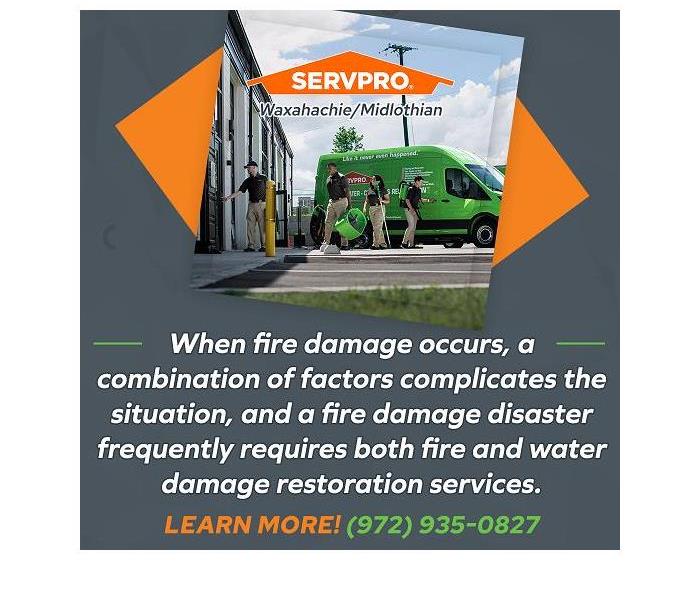Five Ways Water Damage Affects a Fire-Damaged Home
7/16/2022 (Permalink)
Blog Summary: SERVPRO of Waxahachie/Midlothian highlights several reasons why a housefire requires both fire damage restoration and water damage restoration after the flames have been extinguished and the fire department has come and gone.
When fire damage occurs, a combination of factors complicates the situation, and a fire damage disaster frequently requires both fire and water damage restoration services. A house fire is a traumatic experience, and the devastation is often heart-wrenching. Fire, smoke, ash, soot, and water touch everything in the home. Where the visible signs of the disaster are not evident, the smell of charred wood, melted plastic, and burnt fabric permeates the house. The situation calls for the services of property damage restoration professionals who are trained, certified, experienced, well-equipped, and protected. Because a fire damage disaster is so complex and hazardous, cleanup for fire-damaged homes in Red Oak, TX, must be thorough.
A grasp of the complex factors comprising a fire damage disaster must not lightly dismiss or inadvertently overlook the significance of water damage in a fire damage disaster. Fire damage restoration and water damage restoration are inseparably linked. The water may have been introduced by a fire sprinkler system or by high-pressure hoses on the pumper truck. Either way, the water damage will be extensive, escalating the risk hazards and complicating the cleanup and restoration process. On occasion, the water damage from extinguishing the fire exceeds the actual fire damage.
How Water Impacts a Fire Damage Disaster
The amount of water used to extinguish the fire and the application method have a bearing on the extent and type of water damage. A fire hose can stream hundreds of gallons of water per minute into a burning structure. A home should receive a comprehensive inspection for both fire and water damage. Most of the water damage will be in the vicinity of the fire, but the water, like the fire, will have an impact on the entire structure. Some of the water damage will be from direct contact with the water. The moisture, water vapor, and steam from the fire and water mixing will present challenges different from a less complex water damage situation, such as puddled water on the floors and in the crawl space.
Drywall
Drywall is porous and soaks up water. As a result, cleanup and drying may not be sufficient. The drywall may need to be cut out and replaced. Cleaning and restoration professionals can discern what drywall can be dried and salvaged and what must be replaced.
Flooring
Floors are vulnerable to serious damage from water if water removal, drying, and dehumidification are not immediately implemented. Delays can lead to swelling and warping, making the floor beyond recovery. Carpeting and rugs are the most vulnerable to damage from soot, smoke, and water. A combination of extensive water damage, toxins from the fire, and delays in water damage cleanup means the carpet will have to be removed and replaced. Baseboards and floorboards should be examined for swelling and warping. A delay in water removal can lead to the ruin of baseboards that swell to the point that salvaging them is impossible.
Ceilings
If the roof is pierced to allow firefighters to extinguish flames in the attic, then the ceiling will receive extensive water damage. A sagging ceiling may be on the verge of collapsing, which puts occupants in the residence at risk for personal injury. Water spots, signs that water is trapped above the ceiling, may be difficult to identify if the ceiling is discolored with smoke and soot. Qualified fire and water damage cleanup and restoration professionals will be able to spot danger signs on the ceiling.
Personal Belongings
Water in a home damaged by fire will be highly contaminated by smoke and soot. Certain personal belongings are porous and will soak up contaminated water. These items include books, documents, fabric, cushions, and pillows.
Mold
A fire damage disaster that involves water is prone to a mold infestation. Within about 24 to 48 hours, mold can gain a foothold and make a bad situation worse. A rapid response and quick cleanup process that uses the latest equipment, advanced moisture-detecting technology, and EPA-approved cleaning products is crucial to prevent a mold infestation.
A fire damage disaster that also involves water damage is a complex and contaminated disaster scene requiring knowledge, experience, special equipment, cutting-edge moisture detecting technology, and advanced cleaning techniques. Fire leaves behind smoke and soot residue, and everyone working in the environment must be safety-conscious and wear personal protective gear. The professionals at SERVPRO of Waxahachie thoroughly and safely clean and restore any size of fire damage disaster.
To learn more details about water and fire damage cleanup, contact SERVPRO of Waxahachie/Midlothian. The office can be reached by calling (972) 935-0827 or by emailing acarey@SERVPRO10932.com



 24/7 Emergency Service
24/7 Emergency Service
